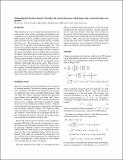Browsing Earth Resources Laboratory by Title
Now showing items 126-145 of 456
-
Electroseismic Investigation Of The Shallow Subsurface: Field Measurements And Numerical Modeling
(Massachusetts Institute of Technology. Earth Resources Laboratory, 1996)Electroseismic phenomena in porous media, first observed almost 60 years ago (Ivanov, 1939), were recently "rediscovered" due to their potential to detect zones of high fluid mobility and fluid chemistry contrasts in the ... -
Electroseismic Logging For The Detection And Characterization Of Permeable Zones: Field Measurements And Theory
(Massachusetts Institute of Technology. Earth Resources Laboratory, 1998)A Stoneley wave propagating in a borehole generates pore fluid flow within the permeable zones intersected by the borehole. In turn, the fluid flow induces a streaming electrical potential. This electrical potential ... -
Electroseismic Waves From Point Sources In Layered Media
(Massachusetts Institute of Technology. Earth Resources Laboratory, 1995)The macroscopic governing equations controlling the coupled electromagnetics and acoustics of porous media are numerically solved for the case of a layered poro-elastic medium.It is shown that these coupled equations ... -
Elimination of LWD (Logging-While-Drilling) Tool Modes Using Seismoelectric Data
(Massachusetts Institute of Technology. Earth Resources Laboratory, 2006)Borehole acoustic logging-while-drilling (LWD) for formation evaluation has become an indispensable part of hydrocarbon reservoir assessment (Tang et al., 2002; Cittá et al., 2004; Esmersoy et al., 2005). However, the ... -
Energy Partitioning and Attenuation of Guided Waves in a Radially Layered Borehole
(Massachusetts Institute of Technology. Earth Resources Laboratory, 1985)Recently published results (Tubman et al., 1984; Baker,. 1984) indicate that synthetic full waveform acoustic logs generated in cased or damaged boreholes differ significantly from those generated in an open hole with ... -
The Equivalent Force System Of A Monopole Source In A Fluid-Filled Open Borehole
(Massachusetts Institute of Technology. Earth Resources Laboratory, 1991)The elastodynamic body-wave field outside a fluid-filled open borehole due to a monopole source in the fluid, is reduced to the radiation-field due to a suitable equivalent force system (EFS) in the absence of the borehole, ... -
Estimate the Effective Elastic Properties of Digitized Porous Rocks by Inverting the Cracks Unresolved
(Massachusetts Institute of Technology. Earth Resources Laboratory, 2010)Current imaging technique such as micro X-ray CT can provide us detailed 3D micro-structures of porous rocks that can be used in numerical simulation so as to predict elastic properties of rocks saturated with different ... -
Estimating A Shear Modulus Of A Transversely Isotropic Formation
(Massachusetts Institute of Technology. Earth Resources Laboratory, 1990)A method to estimate c[subscript 66], which is a shear modulus of a transversely isotropic formation (with its symmetry axis parallel to the borehole), is developed and tested. The inversion for c[subscript 66] is based ... -
Estimating Phase Velocity and Attenuation of Guided Waves in Acoustic Logging Data
(Massachusetts Institute of Technology. Earth Resources Laboratory, 1987)Phase velocity and attenuation of guided waves have been estimated from multireceiver, full waveform, acoustic logging data using the extended Prony's method. Since a formation affects velocity and attenuation, estimating ... -
Estimating Phase Velocity And Attenuation Of Guided Waves In Acoustic Logging Data
(Massachusetts Institute of Technology. Earth Resources Laboratory, 1988)Phase velocity and attenuation of guided waves have been estimated from acoustic logging data recorded by a receiving array. The method uses data from multiple sources and successive depths yielding more accurate estimates ... -
Estimating The Elastic Moduli Of Transversely Isotropic Formations
(Massachusetts Institute of Technology. Earth Resources Laboratory, 1989)Using acoustic logging data, we develop a method of estimating the horizontal shear modulus C[subscript 66]) of a transversely isotropic formation with its axis of symmetry parallel to that of the borehole. The data for ... -
Estimating the fracture density of small-scale vertical fractures when large-scale vertical fractures are present
(Massachusetts Institute of Technology. Earth Resources Laboratory, 2013)When fractures are vertical, aligned and their dimensions are small relative to the seismic wavelength, the medium can be considered to be an equivalent Horizontal Transverse Isotropic (HTI) medium. However, geophysical ... -
Estimation Of Formation Parameters Using Full Waveform Acoustic and Shear Wave Logs
(Massachusetts Institute of Technology. Earth Resources Laboratory, 1992)A combination of borehole Stoneley waves from full waveform acoustic logs and direct shear wave logs was used to estimate formation permeability and shear wave velocity. Data sets used here were collected by Area's array ... -
Estimation of fracture compliance from tubewaves generated at a fracture intersecting a borehole
(Massachusetts Institute of Technology. Earth Resources Laboratory, 2011)Understanding fracture compliance is important for characterizing fracture networks and for inferring fluid flow in the subsurface. In an attempt to estimate fracture compliance in the field, we developed a new model to ... -
Estimation Of Lithologies And Depositional Facies From Wireline Logs
(Massachusetts Institute of Technology. Earth Resources Laboratory, 1999)We approach the problem of identifying facies from well logs though the use of neural networks that perform vector quantization of input data by competitive learning. The method can be used in either an unsupervised or ... -
Estimation Of Nonorthogonal Shear Wave Polarizations And Shear Wave Velocities From Four-Component Dipole Logs
(Massachusetts Institute of Technology. Earth Resources Laboratory, 1996)Polarizations of split shear waves and flexural borehole waves are most commonly estimated from four-component data using the rotation technique of Alford (1986). This method is limited to the case of the two polarizations ... -
Estimation Of Reservoir Properties From Seismic Data By Smooth Neural Networks
(Massachusetts Institute of Technology. Earth Resources Laboratory, 2000)Traditional joint inversion methods reqnire an a priori prescribed operator that links the reservoir properties to the observed seismic response. The methods also rely on a linearized approach to the solution that makes ... -
Evaluation And Prediction Of Shear Wave Velocities In Soft Marine Sediments
(Massachusetts Institute of Technology. Earth Resources Laboratory, 1989)Shear wave velocities from full waveform acoustic logs were determined at DSDP Site 613 using the spectral ratio inversion method. Discrete shear wave velocities for a 350 meter interval at 0.5-2 meter depth increments ... -
Executive Summary
(Massachusetts Institute of Technology. Earth Resources Laboratory, 2000)During the past year we have continued to make progress on the difficult problems associated with extracting geological information from geophysical data sets. Our research results focus on three major areas of ... -
Executive Summary
(Massachusetts Institute of Technology. Earth Resources Laboratory, 2007)ERL's research activities are focused on integrated reservoir characterization and monitoring. In order to maximize the information we can obtain from geophysical measurements, there are two overarching themes: 1. Utilize ...



















